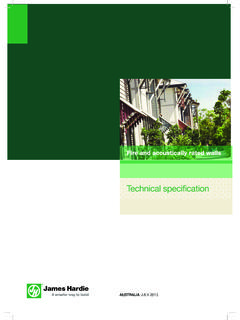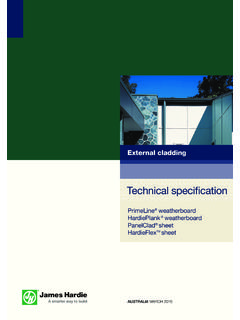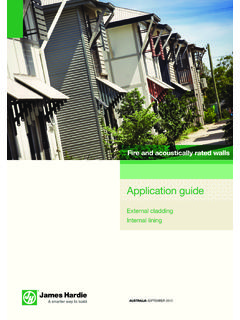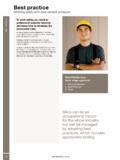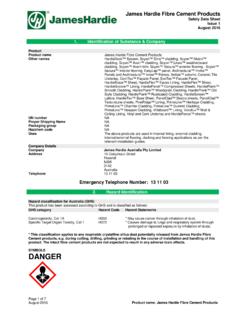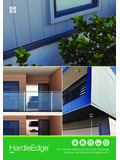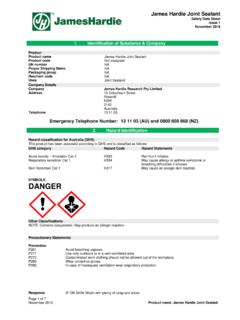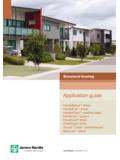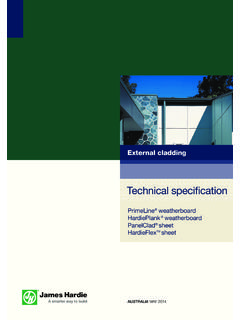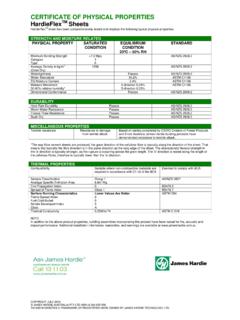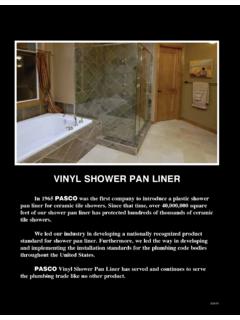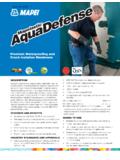Transcription of We ta re ac onstructio n - James Hardie
1 WetareaconstructionApplicationguideJHML1 12614 Frontcoverimage:ShaneDenmanDesignsAUSTRA LIA NOVEMBER 2012 2010 JamesHardieAustraliaPty Ltd. TM and denote a trade mark orregistered mark owned by James HardieTechnology INTRODUCTIONJ ames Hardie manufactures a wide range of building products ideally suited for use in wet areas such as bathrooms, toilets and laundries. Repairs to wet areas such as bathrooms are a nightmare for both homeowner and builder alike. They can be extremely costly, lengthy and disruptive. For this reason it is important to ensure reputable, qualified and skilful tradespeople do the job and suitable and durable building products are it comes to building product performance, James Hardie leads the industry with durable wall linings, structural flooring sheets and ceramic tile underlays. James Hardie building products offer superior durability and are resistant to moisture, rotting, cracking, fire and termites when installed and maintained manual covers the use of James Hardie building products in wet areas.
2 For information relating to the installation, accessories, tools and safe work practices of any James Hardie products refer to the current installation manual and currrent building code of Australia and AS specifier or other responsible party for the project must ensure the information and details in this guide are appropriate for the intended application and specific design and detailing is undertaken for areas which fall outside the scope of this sure your information is up to dateWhen specifying or installing James Hardie products, ensure you have the current manual. Additional installation information, warranties and warnings are available at or Ask James Hardie on 13 11 INTRODUCTION 22 SUITablE wET aREa SUbSTRaTES 3 Wall and ceiling linings 3 Structural flooring sheets 3 Tile underlays 33 COMplIaNCE REqUIREMENTS 4 Building Code of Australia 4 Australian Standard AS 3740 4 Scope of this manual 4 Definitions 4 Waterproofing requirements 5 Benefits of James Hardie building products 54 fRaMINg 65 wall flaShINg 7 Floor/wall junction 7 External flashing 7 Internal flashing 8 Doorway flashing 8 Vertical corner flashing 96 ENClOSED ShOwERS 10 General 10 External membranes 10 Preformed trays and bases 11 Internal membranes 12 shower over baths 12 shower edge details 137 UNENClOSED ShOwERS 148 baThS.
3 BaSINS aND TUbS 15 Baths 15 Basins and tubs 159 pENETRaTIONS 16 Wall penetrations 16 Floor penetrations 1610 appENDIx a 17 WET AREA CONSTRUCTION DESIGN MANUAL NOVEMBER 2012 32 SUITABLE WET AREA SUBSTRATESWALL AND CEILING LININGSV illaboard liningA durable wet area wall and ceiling lining sheet which is a suitable surface for tiled or painted finishes. Available in 6mm, 9mm and 12mm thickness Villaboard lining has its long edges recessed for easy flush-jointing. STRUCTURAL FLOORING ShEETSS cyon Secura interior flooringIt is based on ScyonTM technology. It is a 19mm thick structural flooring tongue and grooved alternate to timber, particle board or plywood flooring. It is lighter than traditional compressed fibre cement and durable with the installation ease of particle Secura interior flooring has been approved by CSIRO (Technical Assessment 318, July 2005) as satisfying the relevant requirements for use in wet compressed sheetAs a structural flooring alternative to timber, particle board or plywood flooring, HardiePanel compressed sheet provide an excellent substrate for ceramic tiles in wet areas.
4 TILE UNDERLAySJames hardieTM Ceramic tile underlay A larger underlay sheet with pre-marked nailing pattern on the face. The larger board size makes it ideal for bigger bathrooms and large floor IN AUSTRALIAMADE IN AUSTRALIAMADE IN AUSTRALIAMADE IN AUSTRALIA4 WET AREA CONSTRUCTION DESIGN MANUAL NOVEMBER 20123 COMPLIANCE REQUIREMENTSBUILDING CODE OF AUSTRALIAT here are two parts to the Building Code of Australia 2006 (BCA).Volume one - Class 2 9 BuildingsVolume two - Class 1 and Class 10 Buildings Housing Provisions. In relation to the waterproofing of wet areas, BCA 2006 Volume one references Australian Standard AS 3740 - Waterproofing of wet areas in residential buildings as meeting the minimum performance requirements for construction of wet areas in Class 2, 3 and 4 buildings. Referencing AS 3740, BCA 2012, Volume two provides specific waterproofing requirements for various applications. These specific requirements are for all intents and purposes the same as those provided in AS STANDARD AS 3740 - 2010AS 3740 specifies the requirements for the physical elements of construction including floors, walls, junctions and penetrations.
5 The specific areas where these criteria apply include showers, areas adjacent to baths and spas, general wet areas and areas adjoining other vessels such as sinks, basins or tubs. The requirements outlined in Appendix A - Table 1 are identical to those provided in Australian Standard AS 3740 (Table ). Additional information relating to the extent of waterproofing required for various applications are provided in Appendix A - Table 2 (this is a copy of Table of AS 3740).SCOPE OF ThIS MANUALThis manual is intended to be used as a guide to assist designers, specifiers, waterproofers, builders and installers achieve construction compliance when using James Hardie building products. It must be read in conjunction with the BCA, AS 3740: 2010 and other relevant regulations relating to wet area of James Hardie building products must be carried out in accordance with the relevant product installation manual current at the time of terminology is used within the regulations and this manual.
6 AS 3740 provides the following definitions:Enclosed shower - A shower designed and installed to control the spread of water from the shower , perimeter - A flashing used at the floor-wall , vertical - A flashing used at wall junctions within shower waste - A grated inlet within a graded floor intended to drain the floor retained water level - The point where surface water will start to overflow out of the shower - A barrier impervious to , external (external flashing) - A membrane that is installed behind the wall sheeting or render. Usually external membranes are preformed trays or sheet material , internal (internal flashing) - A membrane that is installed to the face of the wall sheeting or render. Usually internal membranes are liquid systems applied in area - The area affected by water from a shower , including a shower over a area, enclosed - The area enclosed by walls or screens including hinged or sliding doors that control the spread of water to within the area, unenclosed - The area that is open on one or more sides, extending in an arc on the open sides, 1500mm from the shower connection at the tray - An internal or external liquid or sheet membrane system used to waterproof the floor and the wall/floor junctions of a shower (WP) - The property of a material that does not allow moisture to penetrate through it when tested in accordance with AS/NZS resistant (WR)
7 - The property of a system or material that restricts moisture movement and will not degrade under conditions of area - An area within a building supplied with water from a water supply system and includes bathrooms, showers, laundries and sanitary compartments. Excludes kitchens, bar areas, kitchenettes or domestic food and beverage preparation areas. WET AREA CONSTRUCTION DESIGN MANUAL NOVEMBER 2012 5 WATERPROOFING REQUIREMENTSD ifferent waterproofing requirements are applicable to different wet area applications. Some of those typical applications are shown in Figure various requirements for each application is covered in the following sections of this manual. BENEFITS OF James Hardie BUILDING PRODUCTSJ ames Hardie building products are resistant to moisture damage, rotting, fire, and termites when installed and maintained as directed. In addition to these benefits, when using Scyon Secura interior flooring or HardiePanel compressed sheet, full floor waterproofing is not required outside the enclosed shower area (unless a floor waste is specified by the Scyon interior flooring has been approved by CSIRO (Technical Assessment 318, July 2005) as satisfying the relevant requirements for use in wet walling applications, Villaboard lining covered with tiles is ideal as they meet the water resistant requirements in shower 1 TyPICAL BAThROOM CROSS-SECTION6 WET AREA CONSTRUCTION DESIGN MANUAL NOVEMBER 2012 For vertical corner flashing requirements in shower areas, see page 9.)
8 For internal and external tiled corners located in areas not waterproofed, refer to Figures 4 and 1. Vertical corner flashing is required in shower recess External corners must not be set and plasterer s angles must not to be FRAMINGC orner studs must be blocked to prevent corner cracking, see Figure 2. Where this is not possible, use a metal reinforcing angle such as Rondo 35 x 35 x non-ferrous, corrosion resistant angle, see Figure 3. NOTEP lasterer s angle must not be 2 BLOCkED CORNERFIGURE 3 ANGLE REINFORCED CORNER - NON shower AREAFIGURE 4 INTERNAL TILED CORNER - NON shower AREAFIGURE 5 EXTERNAL TILED CORNER - NON shower AREAB lockingpieceStudsStudsCorrosion resistantNon ferrous nailed at250mm ctrsCornerblockingTimber studFlexible wetarea sealantin 6mm gapVillaboardliningCeramictilesFlexible wetarea sealantVillaboard liningFlexible wetarea sealantin 6mm gapCeramic tilesFlexible wetarea sealant WET AREA CONSTRUCTION DESIGN MANUAL NOVEMBER 2012 7 NOTES1.
9 Where wall/floor junctions are flashed with an external angle (or when an external membrane or base is used), Villaboard lining to be finished with tiles must not be fixed to bottom plates. In these cases, provide an extra row of noggings above top of the flashing/membrane for fixing Villaboard lining. See Figure External flashings (or shower bases) must be fitted before the sheets are External flashing must be fixed to the floor Ensure all elements are compatible to resist corrosion between WALL FLAShINGFLOOR/WALL JUNCTIONThe floor/wall junction requires flashing which can be either an external or internal flashing. In shower recesses, the floor/wall junction must be waterproofed to a height of 150mm above finished tile level of the floor or 25mm minimum above the maximum retained water level, whichever is the greater. This affects the required sealing of the floor to wall junctions in the general wet areas beyond the shower , including bathrooms, toilets and laundries (except kitchens), must be sealed with a flashing or skirting.
10 We recommended this area is sealed with an external horizontal leg of perimeter flashing must be 50mm minimum, and the vertical leg must project 25mm minimum above the highest point of the finished floor surface, except at doorways. Across a doorway, the perimeter flashing angle must finish flush with the top surface of the finished floor. Adhere flashing to floor only. The floor surface must be clean of all waste and dust. Clean down the surfaces to be bonded with a damp cloth and allow to high risk areas such as showers, do not penetrate the corner FLAShINGWhen using external flashing with Villaboard lining, use a 75 x 50mm or 100 x 50mm PVC preformed angle flashing, in conjunction with Fulaprene 303 adhesive, see Figure 6 for Villaboard lining NOTEDo not fix PVC angles with HydrEpoxy 6 EXTERNAL PERIMETER FLAShING - VILLABOARD LININGS FINIShED WITh TILES8 WET AREA CONSTRUCTION DESIGN MANUAL NOVEMBER 2012 INTERNAL FLAShINGA lternatively the wall/floor junction can be flashed internally.
